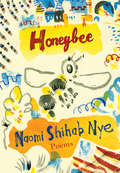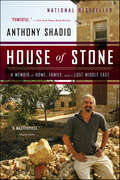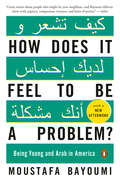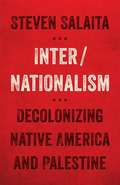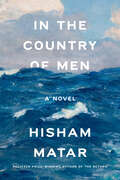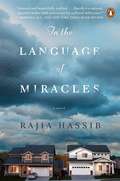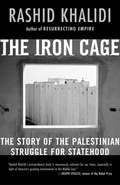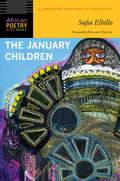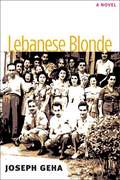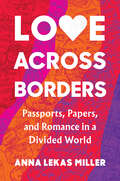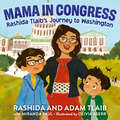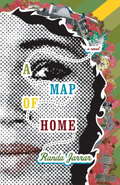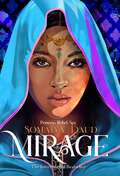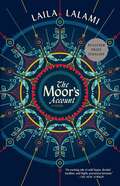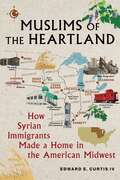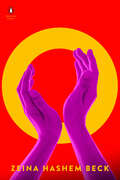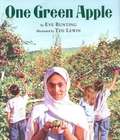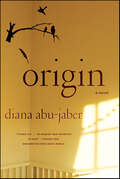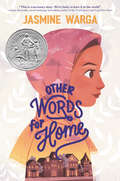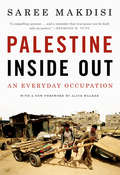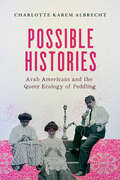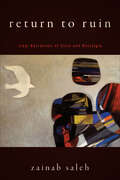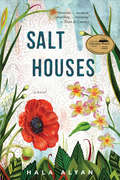Special Collections
Arab American Book Award
- Table View
- List View
Honeybee
by Naomi Shihab NyeHoney. Beeswax. Pollinate. Hive. Colony. Work. Dance. Communicate. Industrious. Buzz. Sting. Cooperate. Where would we be without them? Where would we be without one another? In eighty-two poems and paragraphs, Naomi Shihab Nye alights on the essentials of our time-our loved ones, our dense air, our wars, our memories, our planet-and leaves us feeling curiously sweeter and profoundly soothed.
House of Stone
by Anthony Shadid“Wonderful . . . One of the finest memoirs I’ve read.” — Philip Caputo, Washington PostIn the summer of 2006, racing through Lebanon to report on the Israeli invasion, Anthony Shadid found himself in his family’s ancestral hometown of Marjayoun. There, he discovered his great-grandfather’s once magnificent estate in near ruins, devastated by war. One year later, Shadid returned to Marjayoun, not to chronicle the violence, but to rebuild in its wake.So begins the story of a battle-scarred home and a journalist’s wounded spirit, and of how reconstructing the one came to fortify the other. In this bittersweet and resonant memoir, Shadid creates a mosaic of past and present, tracing the house’s renewal alongside the history of his family’s flight from Lebanon and resettlement in America around the turn of the twentieth century. In the process, he memorializes a lost world and provides profound insights into a shifting Middle East. This paperback edition includes an afterword by the journalist Nada Bakri, Anthony Shadid’s wife, reflecting on his legacy.“A poignant dedication to family, to home, and to history . . . Breathtaking.” — San Francisco Chronicle“Entertaining, informative, and deeply moving . . . House of Stone will stand a long time, for those fortunate enough to read it.” — Telegraph (London)
How Does It Feel to Be a Problem?
by Moustafa BayoumiAn eye-opening look at how young Arab- and Muslim- Americans are forging lives for themselves in a country that often mistakes them for the enemy Just over a century ago , W.E.B. Du Bois posed a probing question in his classic The Souls of Black Folk: How does it feel to be a problem? Now, Moustafa Bayoumi asks the same about America's new "problem"-Arab- and Muslim-Americans. Bayoumi takes readers into the lives of seven twenty-somethings living in Brooklyn, home to the largest Arab-American population in the United States. He moves beyond stereotypes and clichés to reveal their often unseen struggles, from being subjected to government surveillance to the indignities of workplace discrimination. Through it all, these young men and women persevere through triumphs and setbacks as they help weave the tapestry of a new society that is, at its heart, purely American.
Inter/Nationalism
by Steven Salaita&“The age of transnational humanities has arrived.&” According to Steven Salaita, the seemingly disparate fields of Palestinian Studses and American Indian studies have more in common than one may think. In Inter/Nationalism, Salaita argues that American Indian and Indigenous studies must be more central to the scholarship and activism focusing on Palestine. Salaita offers a fascinating inside account of the Boycott, Divestment, and Sanctions (BDS) movement—which, among other things, aims to end Israel&’s occupation of Palestinian land. In doing so, he emphasizes BDS&’s significant potential as an organizing entity as well as its importance in the creation of intellectual and political communities that put Natives and other colonized peoples such as Palestinians into conversation. His discussion includes readings of a wide range of Native poetry that invokes Palestine as a theme or symbol; the speeches of U.S. President Andrew Jackson and early Zionist thinker Ze&’ev Jabotinsky; and the discourses of &“shared values&” between the United States and Israel. Inter/Nationalism seeks to lay conceptual ground between American Indian and Indigenous studies and Palestinian studies through concepts of settler colonialism, indigeneity, and state violence. By establishing Palestine as an indigenous nation under colonial occupation, this book draws crucial connections between the scholarship and activism of Indigenous America and Palestine.
In the Country of Men
by Hisham MatarLibya, 1979.
Nine-year-old Suleiman’s days are circumscribed by the narrow rituals of childhood: outings to the ruins surrounding Tripoli, games with friends played under the burning sun, exotic gifts from his father’s constant business trips abroad.
But his nights have come to revolve around his mother’s increasingly disturbing bedside stories full of old family bitterness. And then one day Suleiman sees his father across the square of a busy marketplace, his face wrapped in a pair of dark sunglasses. Wasn’t he supposed to be away on business yet again? Why is he going into that strange building with the green shutters? Why did he lie?
Suleiman is soon caught up in a world he cannot hope to understand—where the sound of the telephone ringing becomes a portent of grave danger; where his mother frantically burns his father’s cherished books; where a stranger full of sinister questions sits outside in a parked car all day; where his best friend’s father can disappear overnight, next to be seen publicly interrogated on state television.
In the Country of Men is a stunning depiction of a child confronted with the private fallout of a public nightmare. But above all, it is a debut of rare insight and literary grace.
In the Language of Miracles
by Rajia HassibFor readers of House of Sand and Fog, a mesmerizing debut novel of an Egyptian American family and the wrenching tragedy that tears their lives apart
Samir and Nagla Al-Menshawy appear to have attained the American dream. After immigrating to the United States from Egypt, Samir successfully works his way through a residency and launches his own medical practice as Nagla tends to their firstborn, Hosaam, in the cramped quarters of a small apartment. Soon the growing family moves into a big house in the manicured New Jersey suburb of Summerset, where their three children eventually attend school with Natalie Bradstreet, the daughter of their neighbors and best friends.
More than a decade later, the family's seemingly stable life is suddenly upended when a devastating turn of events leaves Hosaam and Natalie dead and turns the Al-Menshawys into outcasts in their own town.
Narrated a year after Hosaam and Natalie's deaths, Rajia Hassib's heartfelt novel follows the Al-Menshawys during the five days leading up to the memorial service that the Bradstreets have organized to mark the one-year anniversary of their daughter's death. While Nagla strives to understand her role in the tragedy and Samir desperately seeks reconciliation with the community, Khaled, their surviving son, finds himself living in the shadow of his troubled brother.
Struggling under the guilt and pressure of being the good son, Khaled turns to the city in hopes of finding happiness away from the painful memories home conjures. Yet he is repeatedly pulled back home to his grandmother, Ehsan, who arrives from Egypt armed with incense, prayers, and an unyielding determination to stop the unraveling of her daughter's family.
In Ehsan, Khaled finds either a true hope of salvation or the embodiment of everything he must flee if he is ever to find himself.
Writing with unflinchingly honest prose, Rajia Hassib tells the story of one family pushed to the brink by tragedy and mental illness, trying to salvage the life they worked so hard to achieve. The graceful, elegiac voice of In the Language of Miracles paints tender portraits of a family's struggle to move on in the wake of heartbreak, to stay true to its traditions, and above all else, to find acceptance and reconciliation
The Iron Cage
by Rashid KhalidiKhalidi (Arab studies, Columbia U.) explains why the Palestinians failed to achieve independence prior to 1948, the date of the establishment of Israel. Rather than "compare the incomparable"--the Palestinians and the Zionist movement--he provides thematically comparisons of the Palestinians to other Arab societies at analogous stages of development. His major themes include the failure of the Palestinians to successfully challenge the legal structure of the mandatory regime, which was consciously designed to prevent Palestinian self-government; the role of British-created religious structures in co-opting Palestinian elites; and the structural failures of the revolt of 1936-39.
The January Children
by Kwame Dawes and Safia ElhilloIn her dedication Safia Elhillo writes, “The January Children are the generation born in Sudan under British occupation, where children were assigned birth years by height, all given the birth date January 1.”
What follows is a deeply personal collection of poems that describe the experience of navigating the postcolonial world as a stranger in one’s own land.
The January Children depicts displacement and longing while also questioning accepted truths about geography, history, nationhood, and home. The poems mythologize family histories until they break open, using them to explore aspects of Sudan’s history of colonial occupation, dictatorship, and diaspora.
Several of the poems speak to the late Egyptian singer Abdelhalim Hafez, who addressed many of his songs to the asmarani—an Arabic term of endearment for a brown-skinned or dark-skinned person. Elhillo explores Arabness and Africanness and the tensions generated by a hyphenated identity in those two worlds. No longer content to accept manmade borders, Elhillo navigates a new and reimagined world.
Maintaining a sense of wonder in multiple landscapes and mindscapes of perpetually shifting values, she leads the reader through a postcolonial narrative that is equally terrifying and tender, melancholy and defiant.
A Kid's Guide to Arab American History
by Yvonne Wakim Dennis and Maha AddasiMany Americans, educators included, mistakenly believe all Arabs share the same culture, language, and religion, and have only recently begun immigrating to the United States.
A Kid's Guide to Arab American History dispels these and other stereotypes and provides a contemporary as well as historical look at the people and experiences that have shaped Arab American culture.
Each chapter focuses on a different group of Arab Americans including those of Lebanese, Syrian, Palestinian, Jordanian, Egyptian, Iraqi, and Yemeni descent and features more than 50 fun activities that highlight their distinct arts, games, clothing, and food.
Kids will love dancing the dabke, constructing a derbekke drum, playing a game of senet, making hummus, creating an arabesque design, and crafting an Egyptian-style cuff bracelet. Along the way they will learn to count in Kurdish, pick up a few Syrian words for family members, learn a Yemeni saying, and speak a little Iraqi.
Short biographies of notable Arab Americans, including actor and philanthropist Danny Thomas, singer Paula Abdul, artist Helen Zughaib, and activist Ralph Nader, demonstrate a wide variety of careers and contributions.
Lebanese Blonde
by Joseph GehaLebanese Blonde takes place in 1975-76 at the beginning of Lebanon's sectarian civil war.
Set primarily in the Toledo, Ohio, "Little Syria" community, it is the story of two immigrant cousins: Aboodeh, a self-styled entrepreneur; and Samir, his young, reluctant accomplice.
Together the two concoct a scheme to import Lebanese Blonde, a potent strain of hashish, into the United States, using the family's mortuary business as a cover.
When Teyib, a newly arrived war refugee, stumbles onto their plans, his clumsy efforts to gain acceptance raise suspicion. Who is this mysterious "cousin," and what dangers does his presence pose?
Aboodeh and Samir's problems grow still more serious when a shipment goes awry and their links to the war-ravaged homeland are severed.
Soon it's not just Aboodeh and Samir's livelihoods and futures that are imperiled, but the stability of the entire family.
Love Across Borders
by Anna Lekas MillerWe are told that love conquers all, but what happens when you don&’t have the right passport? With deep empathy, rigorous reporting, and the irresistible perspective of a true romantic, journalist Anna Lekas Miller tells the stories of couples around the world who must confront Kafkaesque immigration systems to be together—as she did to be with her partner. Written with suspenseful storytelling worthy of the greatest love stories, Love Across Borders takes readers across contentious frontiers around the world, from Turkey to Iraq, Syria to Greece, Mexico to the United States, to reveal the widespread prejudicial laws intent on dividing people. Lekas Miller tells her own story of meeting and falling deeply in love with Salem Rizk, in Istanbul, where they were both reporting on the Syrian War. But when Turkey started cracking down on refugees, Salem, who is Syrian, wasn&’t allowed to stay in the country, nor could he safely return to Syria. He was a man without a country. So Lekas Miller had to decide her next move: she has an American passport, but deep personal ties to the Middle East, and knew it was unfair that Salem couldn&’t travel freely the way she could. More important, she loved him. Over the next few years, as they navigated Salem&’s asylum claims, the United States&’ Muslim ban, and labyrinthine regulations in several different countries, Lekas Miller learned about—and bonded with—other people whose spouses had been deported, who found love in refugee camps, whose differing immigration statuses caused complicated power dynamics and financial hardship or threatened the wellbeing of their children. Here, offering a uniquely diverse, international, and intimate look at the global immigration crisis, she interweaves these rich, complicated love stories with a fascinating look at the history of passports (a surprisingly recent institution), the legacy of colonialism, and the discriminatory laws shaping how people move through the world every day. Ultimately, she builds a powerful, moving case for a borderless society—one where a border patrol agent can&’t keep anyone&’s love story from its happy ending
Mama in Congress
by Miranda Paul and Rashida Tlaib and Adam TlaibAn inspiring picture book that tells the story of Rashida Tlaib, one of the first Muslim women elected to Congress, and her family. Perfect for readers of books that celebrate trailblazing women and social activists as well as those looking for an introduction to civic engagement and how government works."Hey Adam, is the president Mom's boss now?"When Yousif Tlaib asks about his mom's new job in Congress, his older brother, Adam, fills him in—with some help from Rashida Tlaib herself. As he tells his mom’s story, Adam reveals information about how elections and our government work, what it means to break barriers, what motivates their mama to work for justice for all, and how love and family have guided them through this historic time in our country.From growing up in Detroit—the eldest of fourteen siblings and the first in her immigrant family to graduate from high school—through her journey into community activism and then local politics, to eventually becoming one of the first Muslim Congresswomen and an influential national figure, Rashida Tlaib's inspiring story shows kids that they, too, can do great things and make a difference.
A Map of Home
by Randa JarrarNidali, the rebellious daughter of an Egyptian-Greek mother and a Palestinian father, narrates the story of her childhood in Kuwait, her teenage years in Egypt (to where she and her family fled the 1990 Iraqi invasion), and her family's last flight to Texas. Nidali mixes humor with a sharp, loving portrait of an eccentric middle-class family, and this perspective keeps her buoyant through the hardships she encounters: the humiliation of going through a checkpoint on a visit to her father's home in the West Bank; the fights with her father, who wants her to become a famous professor and stay away from boys; the end of her childhood as Iraq invades Kuwait on her thirteenth birthday; and the scare she gives her family when she runs away from home. Funny, charming, and heartbreaking, A Map of Home is the kind of book Tristram Shandy or Huck Finn would have narrated had they been born Egyptian-Palestinian and female in the 1970s.
Mirage
by Somaiya DaudThis “enriching, thrilling, and captivating” (BuzzFeed) Moroccan-inspired debut “has what it takes to be the next big thing in sci-fi/fantasy” (SLJ, starred review)!In a world dominated by the brutal Vathek empire, eighteen-year-old Amani is a dreamer. She dreams of what life was like before the occupation; she dreams of writing poetry like the old-world poems she adores; she dreams of receiving a sign from Dihya that one day, she, too, will have adventure, and travel beyond her isolated home.But when adventure comes for Amani, it is not what she expects: she is kidnapped by the regime and taken in secret to the royal palace, where she discovers that she is nearly identical to the cruel half-Vathek Princess Maram. The princess is so hated by her conquered people that she requires a body double, someone to appear in public as Maram, ready to die in her place.As Amani is forced into her new role, she can’t help but enjoy the palace’s beauty—and her time with the princess’ fiancé, Idris. But the glitter of the royal court belies a world of violence and fear. If Amani ever wishes to see her family again, she must play the princess to perfection...because one wrong move could lead to her death.
The Moor's Account
by Laila LalamiIn this sweeping historical saga of a young man's journey from successful merchant to slave to triumphant survivor, Laila Lalami has crafted "brilliantly imagined fiction...rewritten to give us something that feels very like the truth" (Salman Rushdie).
In 1527, the conquistador Pánfilo de Narváez left the port of San Lucar de Barrameda in Spain with a crew of more than five hundred men. His goal was to claim what is now the Gulf Coast of the United States for the Spanish crown and, in the process, become as wealthy and as famous as Hernán Cortés.
But from the moment the Narváez expedition reached Florida it met with incredibly bad luck - storms, disease, starvation, hostile Indians. Within a year, there were only four survivors: the expedition's treasurer, Cabeza de Vaca; a Spanish nobleman named Alonso del Castillo Maldonado; a young explorer by the name of Andrés Dorantes; and his Moroccan slave, Mustafa al-Zamori.
The four survivors were forced to live as slaves to the Indians for six years, before fleeing and establishing themselves as faith healers. Together, they traveled on foot through present-day Florida, Texas, New Mexico, and Arizona, gathering thousands of disciples and followers along the way. In 1536, they crossed the Rio Grande into Mexican territory, where they stumbled on a group of Spanish slavers, who escorted them to the capital of the Spanish empire, México-Tenochtitlán.
Three of the survivors were asked to provide testimony of their journey--Castillo, Dorantes, and Cabeza de Vaca, who later wrote a book about this adventure, called La Relacíon, or The Account. But because he was a slave, Estebanico was not asked to testify.
His experience was considered irrelevant, or superfluous, or unreliable, or unworthy, despite the fact that he had acted as a scout, an interpreter, and a translator.
This novel is his story.
Muslims of the Heartland
by Edward E Curtis IVThe surprising history of Muslim life in the American Midwest in the early 20th century. The American Midwest is often thought of as uniformly white, and shaped exclusively by Christian values. However, this view of the region as an unvarying landscape fails to consider a significant community at its very heart. Muslims of the Heartland uncovers the long history of Muslims in a part of the country where many readers would not expect to find them. Edward E. Curtis IV, a descendant of Syrian Midwesterners, vividly portrays the intrepid men and women who busted sod on the short-grass prairies of the Dakotas, peddled needles and lace on the streets of Cedar Rapids, and worked in the railroad car factories of Michigan City. This intimate portrait follows the stories of individuals such as farmer Mary Juma, pacifist Kassem Rameden, poet Aliya Hassen, and bookmaker Kamel Osman from the early 1900s through World War I, the Roaring 20s, the Great Depression, and World War II. Its story-driven approach places Syrian Americans at the center of key American institutions like the assembly line, the family farm, the dance hall, and the public school, showing how the first two generations of Midwestern Syrians created a life that was Arab, Muslim, and American, all at the same time.Muslims of the Heartland recreates what the Syrian Muslim Midwest looked, sounded, felt, and smelled like—from the allspice-seasoned lamb and rice shared in mosque basements to the sound of the trains on the Rock Island Line rolling past the dry goods store. It recovers a multicultural history of the American Midwest that cannot be ignored. Choice Outstanding Academic Title 2023
O
by Zeina Hashem Beck&“O is so full of music and passion for life . . . Zeina Hashem Beck&’s poems unfold the abundance of our world.&” —Ilya Kaminsky, author of Deaf Republic From a "brilliant, absolutely essential voice" whose "poems feel like whole worlds" (Naomi Shihab Nye), a poetry collection considering the body physical, the body politic, and the body sacredZeina Hashem Beck writes at the intersection of the divine and the profane, where she crafts elegant, candid poems that simultaneously exude a boundless curiosity and a deep knowingness. Formally electrifying—from lyrics and triptychs to ghazals and Zeina's own duets, in which English and Arabic echo and contradict each other—O explores the limits of language, notions of home and exile, and stirring visions of motherhood, memory, and faith.
One Green Apple
by Eve Bunting and Ted LewinFarah feels alone, even when surrounded by her classmates. She listens and nods but doesn't speak. It's hard being the new kid in school, especially when you're from another country and don't know the language. Then, on a field trip to an apple orchard, Farah discovers there are lots of things that sound the same as they did at home, from dogs crunching their food to the ripple of friendly laughter. As she helps the class make apple cider, Farah connects with the other students and begins to feel that she belongs.Ted Lewin's gorgeous sun-drenched paintings and Eve Bunting's sensitive text immediately put the reader into another child's shoes in this timely story of a young Muslim immigrant.
Origin
by Diana Abu-Jaber"Finally, a novel of literary suspense that gets almost everything right—forensically and psychologically." —Sarah Weinman, Baltimore SunSecretly, in her heart of hearts, Lena Dawson hides the strangest of beliefs about her childhood. Hiding behind a cool competence as a superb fingerprint analyst in a crime lab in snowy Syracuse, New York, she feels totally out of place in the ordinary world of human interaction. Especially since the controlling husband who guided and protected her, then cheated and left her (though now he wants her back). Her uncanny ability to read a crime scene draws her into investigating a mysterious series of crib deaths—but ultimately the most difficult puzzle she must solve is the one of her own origins.Diana Abu-Jaber, a “gifted and graceful writer” (Chicago Tribune), masterfully “transcends formula” (Kirkus Reviews) as “the tension of Origin escalates, shaped as much by beautifully nuanced prose as menacing events” (New York Daily News).
The Other Americans
by Laila LalamiFrom the Pulitzer Prize finalist and author of The Moor’s Account, here is a timely and powerful novel about the suspicious death of a Moroccan immigrant—at once a family saga, a murder mystery, and a love story, informed by the treacherous fault lines of American culture. Late one spring night, Driss Guerraoui, a Moroccan immigrant living in California, is walking across a darkened intersection when he is killed by a speeding car. The repercussions of his death bring together a diverse cast of characters: Guerraoui’s daughter Nora, a jazz composer who returns to the small town in the Mojave she thought she'd left for good; his widow, Maryam, who still pines after her life in the old country; Efraín, an undocumented witness whose fear of deportation prevents him from coming forward; Jeremy, an old friend of Nora's and an Iraq War veteran; Coleman, a detective who is slowly discovering her son's secrets; Anderson, a neighbor trying to reconnect with his family; and the murdered man himself. As the characters—deeply divided by race, religion, and class—tell their stories, connections among them emerge, even as Driss’s family confronts its secrets, a town faces its hypocrisies, and love, messy and unpredictable, is born.
Other Words for Home
by Jasmine WargaA gorgeously written, hopeful middle grade novel in verse about a young girl who must leave Syria to move to the United States, perfect for fans of Jason Reynolds and Aisha Saeed.
Jude never thought she’d be leaving her beloved older brother and father behind, all the way across the ocean in Syria.
But when things in her hometown start becoming volatile, Jude and her mother are sent to live in Cincinnati with relatives.
At first, everything in America seems too fast and too loud. The American movies that Jude has always loved haven’t quite prepared her for starting school in the US—and her new label of “Middle Eastern,” an identity she’s never known before.
But this life also brings unexpected surprises—there are new friends, a whole new family, and a school musical that Jude might just try out for. Maybe America, too, is a place where Jude can be seen as she really is.
This lyrical, life-affirming story is about losing and finding home and, most importantly, finding yourself.
A New York Times Bestseller
Palestine Inside Out
by Alice Walker and Saree MakdisiTending one's fields, visiting a relative, going to the hospital: for ordinary Palestinians, such activities require negotiating permits and passes, curfews and closures, "sterile roads" and "seam zones"--bureaucratic hurdles ultimately as deadly as outright military incursion.
In Palestine Inside Out, Saree Makdisi draws on eye-opening statistics, academic histories, UN reports, and contemporary journalism to reveal how the "peace process" institutionalized Palestinians' loss of control over their inner and outer lives--and argues powerfully and convincingly for a one-state solution.
Possible Histories
by Charlotte Karem AlbrechtA free ebook version of this title is available through Luminos, University of California Press’s Open Access publishing program. Visit www.luminosoa.org to learn more. Many of the hundreds of thousands of Syrians who immigrated to the US beginning in the 1870s worked as peddlers. Men were able to transgress Syrian norms related to marriage practices while they were traveling, while Syrian women accessed more economic autonomy though their participation in peddling networks. In Possible Histories, Charlotte Karem Albrecht explores this peddling economy of the late nineteenth and early twentieth centuries as a site for revealing how dominant ideas about sexuality are imbricated in Arab American racial histories. Karem Albrecht marshals a queer affective approach to community and family history to show how Syrian immigrant peddlers and their interdependent networks of labor and care appeared in interconnected discourses of modernity, sexuality, gender, class, and race. Possible Histories conceptualizes this profession, and its place in narratives of Arab American history, as a "queer ecology" of laboring practices, intimacies, and knowledge production. This book ultimately proposes a new understanding of the long arm of Arab American history that puts sexuality and gender at the heart of ways of navigating US racial systems.
Return to Ruin
by Zainab SalehWith the U.S. invasion of Iraq, Iraqis abroad, hoping to return one day to a better Iraq, became uncertain exiles. Return to Ruin tells the human story of this exile in the context of decades of U.S. imperial interests in Iraq—from the U.S. backing of the 1963 Ba'th coup and support of Saddam Hussein's regime in the 1980s, to the 1991 Gulf War and 2003 invasion and occupation. Zainab Saleh shares the experiences of Iraqis she met over fourteen years of fieldwork in Iraqi London—offering stories from an aging communist nostalgic for the streets she marched since childhood, a devout Shi'i dreaming of holy cities and family graves, and newly uprooted immigrants with fresh memories of loss, as well as her own. Focusing on debates among Iraqi exiles about what it means to be an Iraqi after years of displacement, Saleh weaves a narrative that draws attention to a once-dominant, vibrant Iraqi cultural landscape and social and political shifts among the diaspora after decades of authoritarianism, war, and occupation in Iraq. Through it all, this book illuminates how Iraqis continue to fashion a sense of belonging and imagine a future, built on the shards of these shattered memories.
Salt Houses
by Hala AlyanOn the eve of her daughter Alia’s wedding, Salma reads the girl’s future in a cup of coffee dregs. She sees an unsettled life for Alia and her children; she also sees travel, and luck. While she chooses to keep her predictions to herself that day, they will all soon come to pass when the family is uprooted in the wake of the Six-Day War of 1967.
Salma is forced to leave her home in Nablus; Alia’s brother gets pulled into a politically militarized world he can’t escape; and Alia and her gentle-spirited husband move to Kuwait City, where they reluctantly build a life with their three children.
When Saddam Hussein invades Kuwait in 1990, Alia and her family once again lose their home, their land, and their story as they know it, scattering to Beirut, Paris, Boston, and beyond.
Soon Alia’s children begin families of their own, once again navigating the burdens (and blessings) of assimilation in foreign cities.
Lyrical and heartbreaking, Salt Houses is a remarkable debut novel that challenges and humanizes an age-old conflict we might think we understand—one that asks us to confront that most devastating of all truths: you can’t go home again.
